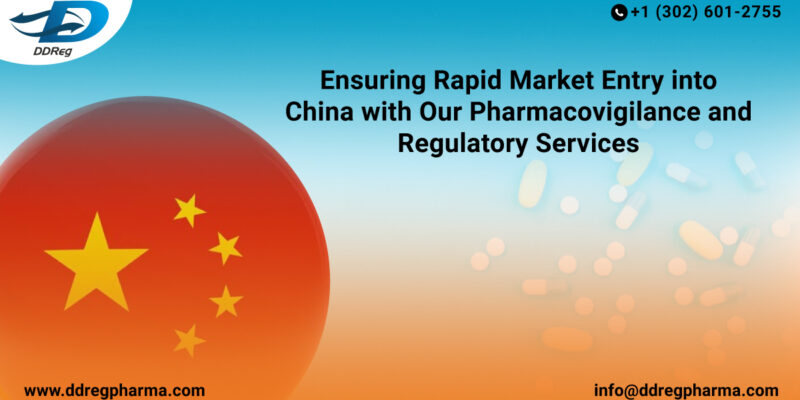
Introduction:
China’s pharmaceutical industry is experiencing a transformative phase, driven by rapid economic growth, technological advancements, and evolving regulatory standards. As the second-largest pharmaceutical market globally, China plays a critical role in shaping the future of drug regulation. In this blog, we delve into the dynamic landscape of drug regulation in China, with a particular focus on the pivotal roles of pharmacovigilance and regulatory services.
Understanding China’s Regulatory Landscape:
The regulatory framework governing pharmaceuticals in China has undergone significant reforms in recent years. The establishment of the National Medical Products Administration (NMPA) marked a significant step towards consolidating regulatory oversight and streamlining approval processes. The NMPA is responsible for overseeing drug registration, quality control, and post-market surveillance, among other regulatory functions. Furthermore, China has implemented stringent regulations aimed at enhancing drug safety and efficacy standards, aligning with international best practices and fostering innovation in the pharmaceutical sector.
The Role of Pharmacovigilance:
Pharmacovigilance, the science of monitoring and assessing the safety of medicines, plays a crucial role in China’s regulatory framework. With the increasing complexity of drug development and the growing demand for post-market surveillance, pharmacovigilance has gained prominence as an essential tool for identifying and mitigating potential risks associated with pharmaceutical products. By fostering collaboration between regulatory authorities, healthcare professionals, and pharmaceutical companies, pharmacovigilance contributes to safeguarding public health and enhancing drug safety in China.
Pharmacovigilance Services in China encompass various aspects, including adverse drug reaction (ADR) reporting, signal detection, risk assessment, and risk management. The implementation of pharmacovigilance guidelines and regulations has led to improved surveillance systems and enhanced reporting mechanisms, enabling more effective monitoring of drug safety issues. Additionally, China has been actively participating in international pharmacovigilance initiatives and collaborations, facilitating knowledge exchange and capacity building in this critical area.
Emerging Trends in Regulatory Services:
Regulatory services are evolving to meet the dynamic needs of the pharmaceutical industry in China. Regulatory consulting firms and service providers offer a wide range of services, including regulatory strategy development, dossier preparation, submission support, and lifecycle management. These services play a vital role in assisting pharmaceutical companies navigate the complex regulatory landscape and ensure compliance with evolving regulations.
One of the notable trends in regulatory services is the increasing emphasis on digitalization and technology-driven solutions. With the advent of electronic submission platforms and digital regulatory tools, regulatory processes are becoming more efficient and streamlined. Moreover, the implementation of reforms such as the Marketing Authorization Holder (MAH) system has opened up new opportunities for regulatory service providers to support pharmaceutical companies in navigating regulatory requirements and accelerating market access for new drugs.
Challenges and Opportunities Ahead:
Despite the progress made in drug regulation in China, several challenges persist. One of the key challenges is the need for regulatory harmonization and alignment with international standards. Achieving regulatory convergence with global regulatory agencies will facilitate smoother market access for multinational pharmaceutical companies and promote innovation in the Chinese pharmaceutical industry.
Another challenge is the enhancement of pharmacovigilance infrastructure and capacity building. While significant strides have been made in improving pharmacovigilance systems and processes, there is still room for improvement in areas such as ADR reporting, signal detection, and risk assessment. Strengthening pharmacovigilance capabilities will be crucial for ensuring the timely detection and management of adverse drug reactions and enhancing public health outcomes.
Furthermore, promoting data transparency and enhancing regulatory efficiency will be imperative for fostering trust and confidence in China’s regulatory system. Transparency in regulatory processes and decision-making is essential for promoting accountability and building credibility with stakeholders. Moreover, streamlining regulatory processes and reducing administrative burden will facilitate faster market access for innovative drugs and medical products, ultimately benefiting patients and healthcare providers.
Conclusion:
As China’s pharmaceutical industry continues to evolve, the future of drug regulation hinges on the effective integration of pharmacovigilance and regulatory services. By embracing innovation, collaboration, and continuous improvement, stakeholders can pave the way for a safer, more efficient, and more sustainable pharmaceutical ecosystem in China and beyond. Through exploring the synergies between pharmacovigilance and regulatory services, we can chart a course towards a future where patient safety and drug efficacy are prioritized, ensuring a healthier tomorrow for all.
https://emperiortech.com/
Pharmacovigilance Services in China ensure drug safety, monitoring adverse effects post-market, while Regulatory Services in China govern the authorization and compliance of therapeutic goods, upholding healthcare standards.
What's your reaction?
Excited
0 Happy
0 In Love
0 Not Sure
0 Silly
0









